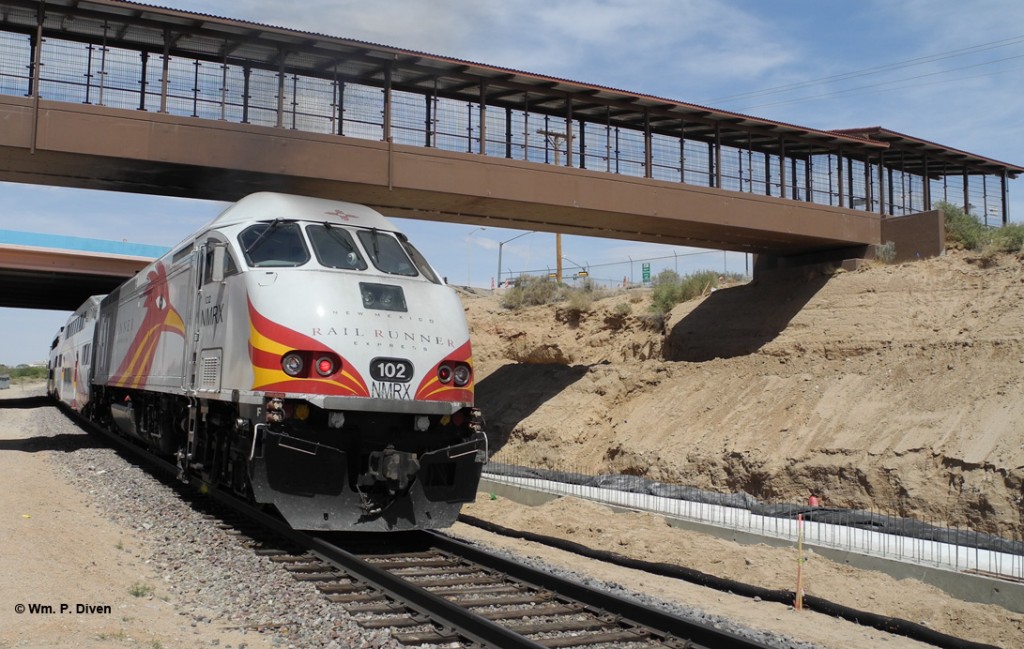The big meeting of folks trying to keep Amtrak’s Southwest Chief running through northern New Mexico and Albuquerque has come and gone with nary a peep in the state’s biggest city.
There’s a mayoral election here in three weeks, so you’d think the prospect of Albuquerque losing rail passenger service would be an issue. Well, think again. It’s called a nonpartisan election although that thin veneer peeled off several elections ago. The all-business Republican incumbent is silent on the issue, perhaps in part so as not to stir up trouble for the Republican governor, and the openly Democratic challenger and a third candidate, both well behind in the polls, seem unable to recognize an issue when it’s handed to them.
Albuquerque recorded an official 78,324 passenger arrivals and departures for the year ending Sept. 30, 2012, with Raton, Las Vegas and Lamy combining for about 45,000 more, according to Amtrak’s figures. That’s a lot of folks including Boy Scouts headed to Philmont Scout Ranch who’ll be seeking alternate transport if Amtrak shifts to the central route through Clovis, Belen and Gallup. A decent number of tourists with disposable income may also decide to go someplace other than supposedly tourist-friendly New Mexico when faced with replacement bus service, such as it is.
Political leaders in Kansas and Colorado at least gave a nod to the the issue before saying they don’t have the money to maintain the tracks that have lost most of their freight traffic. The fight to preserve the current route is being led in large part by the private Colorado Rail Passenger Association, which organized the Sept. 14 meeting in Pueblo, and its mostly civilian allies in the other states. A Santa Fe photographer is leading the ad-hoc group here, but the usual business boosters who raise funds to pass bond issues and defeat minimum-wage proposals are sitting on their hands instead of organizing a Save the Chief effort.

A Rail Runner Express train operating in push mode and bound for Santa Fe departs Bernalillo, N.M., on May 5, 2013.
When Democrat Gov. Bill Richardson announced New Mexico was buying the BNSF Railway tracks from Belen to the top of Raton Pass for the Rail Runner Express commuter trains, he crowed about spending only $5 million for the 182-mile Lamy-Raton Pass segment and how continuing freight traffic would help underwrite maintenance costs. BNSF, however, soon shifted all the line’s Colorado and West Coast-Kansas City traffic to the central route leaving the daily east-west Southwest Chiefs as the only trains on the lonesome high plains. Meanwhile Rail Runner trains to Santa Fe carved a new route up Waldo Canyon to the Interstate 25 median to reach Santa Fe bypassing a logical park-and-ride stop at Cerrillos and a likely fight over right-of-way acquisition.
Republican Gov. Susana Martinez came into office on Jan. 1, 2011, hating anything with Big Bill’s imprint on it, specifically Rail Runner and his other high-dollar legacy, Spaceport America in Sierra County. She grudgingly warmed up to the spaceport but probably would have killed Rail Runner if a) voters hadn’t already approved a sales tax to support operations by a regional transit district, and b) Big Bill structured things so you’d still have a huge debt to pay off even if the trains stopped running. The only sign of her interest in railroads was pushing fuel-tax breaks for a new Union Pacific facility in the Santa Teresa industrial area near the Mexican border and a talked-about BNSF fueling station and possible warehousing development outside Belen.
(The governor backed out of Big Bill’s deal to buy the Lamy-Raton line, got back the state’s $5 million plus $50 million escrowed against liabilities and essentially claimed to have held the tax break hostage until BNSF agreed to cancel the track-purchase contract. BNSF doesn’t talk publicly about its politics and business negotiations, which means we’ll likely never know what the state actually did and said out of public view. Stiil, one doubts the vocally pro-business governor would want to take the fall for killing a big-business jobs and development project over an issue she can blame on Bill Richardson. BNSF and its predecessor were skilled horse traders long before New Mexico became a state and know a lot more about unloading nags and corralling thoroughbreds than most políticos. So BNSF management and wily owner Warren Buffet may still see value in the line despite any political posturing in Santa Fe. ¿Quien sabe?)
Regardless of what happens to the Southwest Chief, someone will pay. If neither the states nor the feds can find some way to keep up the tracks or spend economic-development money to bring in rail-based industry, then national taxpayers will be asked to foot the bill for what BNSF claims the reroute will cost. The figure of $100 million gets kicked around for both the reroute and needed maintenance on the Raton line. The current Amtrak contract with BNSF is up in 2016, and a decision on which way to go is to be made in 2014. Current betting leans toward Amtrak making the shift with Albuquerque settling for a bus connection to a trackside shelter somewhere near Belen since that city’s former station is in a bustling freight yard no longer friendly to passenger trains.

